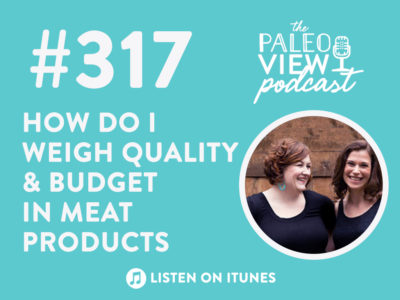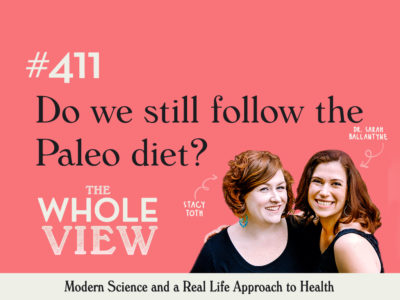In this episode, Stacy and Sarah talk about the quality of meat products. What do all these terms like grass-fed, pasture-raised, and free-range mean? How do I select for quality and budget? And what should I weigh when my budget can’t handle all high-quality meat?
Click here to listen in iTunes
or download and listen by clicking the PodBean Player below
![]()
If you enjoy the show, please review it in iTunes!
The Paleo View (TPV), Episode 317: How Do I Weigh Quality and Budget in Meat Products?
- Intro (0:00)
- News and Views (0:40)
- Sarah is back from her camping! It was an eventful trip full of bears, poison ivy, and meeting park rangers!
- We’re talking meat quality, and have a deal for you from ButcherBox, the best subscription for high-quality meats! Sarah has a subscription and loves it!
- Offer for paleo view listeners: $15 off + Free Bacon with a subscription (ButcherBox Bacon is uncured, free of sugar and nitrates, non-GMO verified, hormone free, made from pasture-raised heritage breed pigs AND its whole30 approved!)
- Link to use: https://www.butcherbox.com/thepaleoview/
- No coupon needed!
- You can also get items a la carte like Stacy does!
- Question from Deborah: “I have been trying to find a place to get pastured chicken but even those that claim to be grass fed still are fed grains. If I eat a chicken that’s been raised on grains is that going to be bad for staying on AIP?”
- First of all, there is no such thing as grass-fed chicken! They are omnivores and don’t eat grass!
- Conventionally-raised meat refers to factory farming:
- animals are raised indoors,
- small pens with little to no room to move
- fed fattening grain-based diets
- dosed with antibiotics and hormones
- Just like eating our natural diet makes us healthier, the same is true for animals.
- Animals are healthiest when they are
- raised outdoors with plenty of space to move around
- improved living conditions
- fed a natural diet for the species animal (pasture for sheep and cows, forage for pigs and chickens)
- Benefits:
- more humane (Stacy was a vegetarian for years because of this concern, it feeds vegan propaganda!)
- little need for antibiotics
- environmentally protective (lower carbon footprint, supports family-farms, does not support mono-crop industrial farming)
- improves the nutrient-content of the meat
- meat does not contain antibiotics (meaning their gut microbiomes are healthy) or hormones
- grass-fed comes from an herbivore (eg. beef, bison and lamb)
- pasture-raised comes from an omnivore (eg. chicken, turkey, and pork)
- Check out Beyond Bacon about how much we love Pork!
- Grass-fed vs Grass-finished (Some producers “grain-finish” their meat in order to increase the size of the cattle and can be somewhat cagey about this fact.)
- It only takes a few weeks of “grain-finishing” to eliminate most of the benefits of grass feeding!
- Some producers supplement with grain so the animals are “mostly grass-fed,”
- Organic is not the same as grass-fed; although grass-fed meat may also be organic, organic meat is not usually grass-fed.
- What is the benefits of grass fed?
- The frequency of E. coli contamination of grass-fed meat is extremely low compared to conventional meat in spite of the fact that while antibiotic use is routine in factory farming, antibiotics are not used at all in grass-fed animals
- Grass-fed is higher in micronutrients: vitamin A (10 times more than grain-fed), vitamin E (three times more than grain-fed), higher in B vitamins, calcium, magnesium, and potassium.
- Grass-fed meat also tends to have a much lower water content and is much leaner than conventional meat, which means that it is higher in protein.
- The fats in grass-fed meat are healthier: Amounts of saturated, monounsaturated and omega-6 fatty acids are similar, but grass-fed meat contains approximately four times more omega-3 fatty acids (DHA and EPA)
- richest known source of CLA (at least double conventional)
- CLA is a wonder fat, a natural trans fat that reduces cancer risk, reduces cardiovascular disease, helps with weight loss (reduces appetite, inhibits fat production, stimulates the breakdown of fat, increases metabolism), reduces diabetes via reducing inflammation-induced insulin resistance
- Pigs are also omnivores; their natural diet includes plants of all kinds, bugs, small animals and carrion.
- Pasture-raised pigs are healthier too, with far, far lower rates of contamination with antibiotic-resistant strains of bacteria (notably salmonella and E. coli).
- The meat from pigs raised on pasture tends to be leaner overall, contains more omega-3 fats and less omega-6 fats, lower in saturated fat, higher in monounsaturated fat, and higher in protein, higher in vitamins B1 and B2, vitamin E, antioxidant phenolic compounds, and tends to be higher in zinc, copper and iron.
- Pork fat (lard) is one of the highest natural sources of dietary Vitamin D!
- See Beyond Bacon, of course, on how to make it!
- Chickens and turkeys are omnivores; their natural diet includes grains, grasses, and bugs (they’re not vegetarians!)
- Pasture-raised chickens are healthier too, with far, far lower rates of contamination with antibiotic-resistant strains of bacteria (notably salmonella and E. coli).
- We don’t eat a lot of poultry because of its fatty acid profile. Poultry is the richest source of omega-6 of any animal food
- conventional chicken fat is almost 20 percent omega-6 as a percentage of total energy, more than canola oil (19 percent omega-6) and not too far behind peanut butter (22.5 percent)
- chicken contributes an average of 13 percent of the omega-6 content to the average American diet!
- “Free-range” isn’t enough to turn the fatty acid tables. Research focusing on the effects of different poultry farming methods (caged versus free-range) and diets (conventional, organic, or pasture access) have had mixed results and suggest that the labeling we associate with higher-quality chicken doesn’t guarantee a better fatty acid profile for the birds.
- Some studies of cereal-fed chickens with or without access to pasture show no difference in omega-3 to omega-6 ratio, unless the birds’ intake of cereal grains is deliberately restricted (which sometimes increases their levels of the omega-3 fats.
- Likewise, meat from chickens that pasture-graze in the spring but not in other seasons tends to have higher levels of omega-3 fats.
- And some studies of free-range versus conventional chicken have shown that free-range breast and thigh meat has a worse omega-3 to omega-6 ratio than the same meat from conventionally raised birds!
- One study found that chickens fed soy-containing diets had an omega-3 to omega-6 ratio of 1:8, while those fed soy-free diets had a much-improved ratio of 1:3.
- Another study of chickens raised predominantly on grasshoppers showed that those chickens had an omega-3 to omega-6 fatty acid ratio of approximately 1:7
- studies of chickens supplemented with large amounts of flax seeds were able to achieve a 1:1 ratio of omega-3 to omega-6 (although a high percentage was ALA as opposed to DHA and EPA).
- For comparison, a chicken labeled “organic free-range” had a typical ratio of 1:11.6, and a chicken labeled “non-organic free-range” had a ratio of 1:11.3.
- Studies of turkey have shown similar omega-3 to omega-6 patterns related to diet and forage access.
- Of course, grass-fed and pasture-raised meat tends to be more expensive. But, you’re getting denser protein, more vitamins and minerals, and healthier fats!
- Get for grass-fed and pasture-raised when buying cheaper, fattier cuts (like 80/20 ground beef, a nicely marbled steak, or pork shoulder), since toxins are stored in fat and to take full advantage of the healthier fats and higher levels of fat-soluble vitamins in high-quality meat.
- buy leaner cuts (strip steaks, chicken breast or pork tenderloin) from conventional sources.
- when we can’t afford to have all our meat come from grass-fed, pastured, and wild sources (or can’t access these products where we live), even conventional meat provides essential nutrients that we can’t do without.
- Get your ButcherBox! Offer for paleo view listeners: $15 off + Free Bacon with a subscription (ButcherBox Bacon is uncured, free of sugar and nitrates, non-GMO verified, hormone free, made from pasture-raised heritage breed pigs AND its whole30 approved!)
Link to use: https://www.butcherbox.com/thepaleoview/ - Get your questions in! We want to hear from you! And there’s no end to questions we can answer and topics we can address!
- Engage on social media! That’s how we get feedback!
- Thank you for listening!










